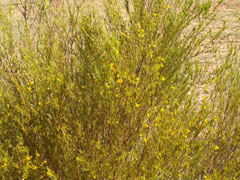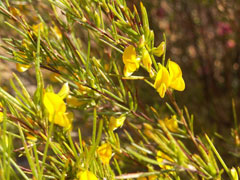 |
|
http://commons.wikimedia.org/wiki/User:Amrum |
 |
| http://commons.wikimedia.org/wiki/User:Amrum |
Translate this page:
Summary
Physical Characteristics

 Aspalathus linearis is a SHRUB growing to 2 m (6ft 7in).
Aspalathus linearis is a SHRUB growing to 2 m (6ft 7in).
See above for USDA hardiness. It is hardy to UK zone 9. It is in flower from July to August. The species is hermaphrodite (has both male and female organs).
It can fix Nitrogen.
Suitable for: light (sandy) and medium (loamy) soils and prefers well-drained soil. Suitable pH: mildly acid and neutral soils. It cannot grow in the shade. It prefers dry or moist soil and can tolerate drought.
UK Hardiness Map
US Hardiness Map
Synonyms
Plant Habitats
South Wall. By. West Wall. By.
Edible Uses
Edible Parts:
Edible Uses: Condiment Tea
A tea made from the dried fermented leaves tastes similar to oriental tea made from Camellia sinensis[238]. It is less astringent, however, due to the lower tannin content[238]. It is caffeine-free, but has a higher content of fluoride which might help to protect against tooth decay[238]. Recent research has shown that this tea contains a substance similar to superoxide dismutase, an antioxidant compound that is thought to retard the ageing process[238]. The leaves and stems are harvested in the summer, fermented and sun dried for later use[238]. The leaves are sometimes used as a flavouring in foods and in baking[268].
References More on Edible Uses
Medicinal Uses
Plants For A Future can not take any responsibility for any adverse effects from the use of plants. Always seek advice from a professional before using a plant medicinally.
Antipsoriatic Antispasmodic Eczema Tonic
Rooibos was traditionally used by the Bushmen and Hottentots of South Africa and is becoming increasingly popular in the West as a pleasant tasting tea that also has health benefits[268]. A tea made from the leaves and stems of rooibos is generally beneficial to the digestive system and relaxes spasms[238], it has been used in the treatment of vomiting, diarrhoea and other mild gastric complaints[268]. It has also been shown to be of benefit when used internally and externally in the treatment of a wide range of allergies especially milk allergy[268], eczema, hay fever and asthma in infants[238].
References More on Medicinal Uses
The Bookshop: Edible Plant Books
Our Latest books on Perennial Plants For Food Forests and Permaculture Gardens in paperback or digital formats.

Edible Tropical Plants
Food Forest Plants for Hotter Conditions: 250+ Plants For Tropical Food Forests & Permaculture Gardens.
More

Edible Temperate Plants
Plants for Your Food Forest: 500 Plants for Temperate Food Forests & Permaculture Gardens.
More

More Books
PFAF have eight books available in paperback and digital formats. Browse the shop for more information.
Shop Now
Other Uses
References More on Other Uses
Cultivation details
Requires a very well-drained acid sandy soil and a warm sunny position[200]. When grown in pots it needs to be kept dry but not arid in the winter[200]. This species tolerates several degrees of frost in its native habitat[200], though this cannot be applied directly to plants grown in Britain because of our cooler summers and colder, wetter winters. Plants are said to be frost-tolerant in one report[238], but in general plants are usually pot-grown in greenhouses in this country and can be brought into the garden for the summer[200]. Cultivated commercially for its leaves, which are used to make a tea. Rooibos is one of the few wild species to have been developed as a commercial crop in the last 100 years[238]. It is grown for use as a tea, though it is also used medicinally[238]. Commercial plantations last for about 7 years before they need to be replaced. This species has a symbiotic relationship with certain soil bacteria, these bacteria form nodules on the roots and fix atmospheric nitrogen. Some of this nitrogen is utilized by the growing plant but some can also be used by other plants growing nearby[200].
References Carbon Farming Information and Carbon Sequestration Information
Temperature Converter
Type a value in the Celsius field to convert the value to Fahrenheit:
Fahrenheit:
The PFAF Bookshop
Plants For A Future have a number of books available in paperback and digital form. Book titles include Edible Plants, Edible Perennials, Edible Trees,Edible Shrubs, Woodland Gardening, and Temperate Food Forest Plants. Our new book is Food Forest Plants For Hotter Conditions (Tropical and Sub-Tropical).
Shop Now
Plant Propagation
Seed - sow late spring in a greenhouse covering the seed with about 10mm of soil[238, 268]. It will probably be beneficial to pre-soak the seed for 12 hours in warm water prior to sowing. Prick out the seedlings into individual pots of well-drained sandy soil as soon as they are large enough to handle. Grow them on in the greenhouse for at least their first winter and plant them out in late spring or early summer after the last expected frosts. It will probably be wise to give the plants protection from the cold and from excessive rain for at least their first winter outdoors. Cuttings of half-ripe wood in a closed frame in early summer[200].
Other Names
If available other names are mentioned here
Kaffree, Redbush tea, Red tea,
Native Range
AFRICA: South Africa (Western Cape)
Weed Potential
Right plant wrong place. We are currently updating this section.
Please note that a plant may be invasive in one area but may not in your area so it's worth checking.
Conservation Status
IUCN Red List of Threatened Plants Status :

Growth: S = slow M = medium F = fast. Soil: L = light (sandy) M = medium H = heavy (clay). pH: A = acid N = neutral B = basic (alkaline). Shade: F = full shade S = semi-shade N = no shade. Moisture: D = dry M = Moist We = wet Wa = water.
Now available:
Food Forest Plants for Mediterranean Conditions
350+ Perennial Plants For Mediterranean and Drier Food Forests and Permaculture Gardens.
[Paperback and eBook]
This is the third in Plants For A Future's series of plant guides for food forests tailored to
specific climate zones. Following volumes on temperate and tropical ecosystems, this book focuses
on species suited to Mediterranean conditions—regions with hot, dry summers and cool, wet winters,
often facing the added challenge of climate change.
Read More
Expert comment
Author
(Burm.f.)R.Dahlgren.
Botanical References
200
Links / References
For a list of references used on this page please go here
Readers comment